Review of Hybrid Aerial Underwater Vehicle: Potential Applications in the Field of Underwater Marine Optics
Abstract
1. Introduction
2. Hybrid Underwater Vehicle Progress
2.1. The Splash Entry/Exit Way HAUVs
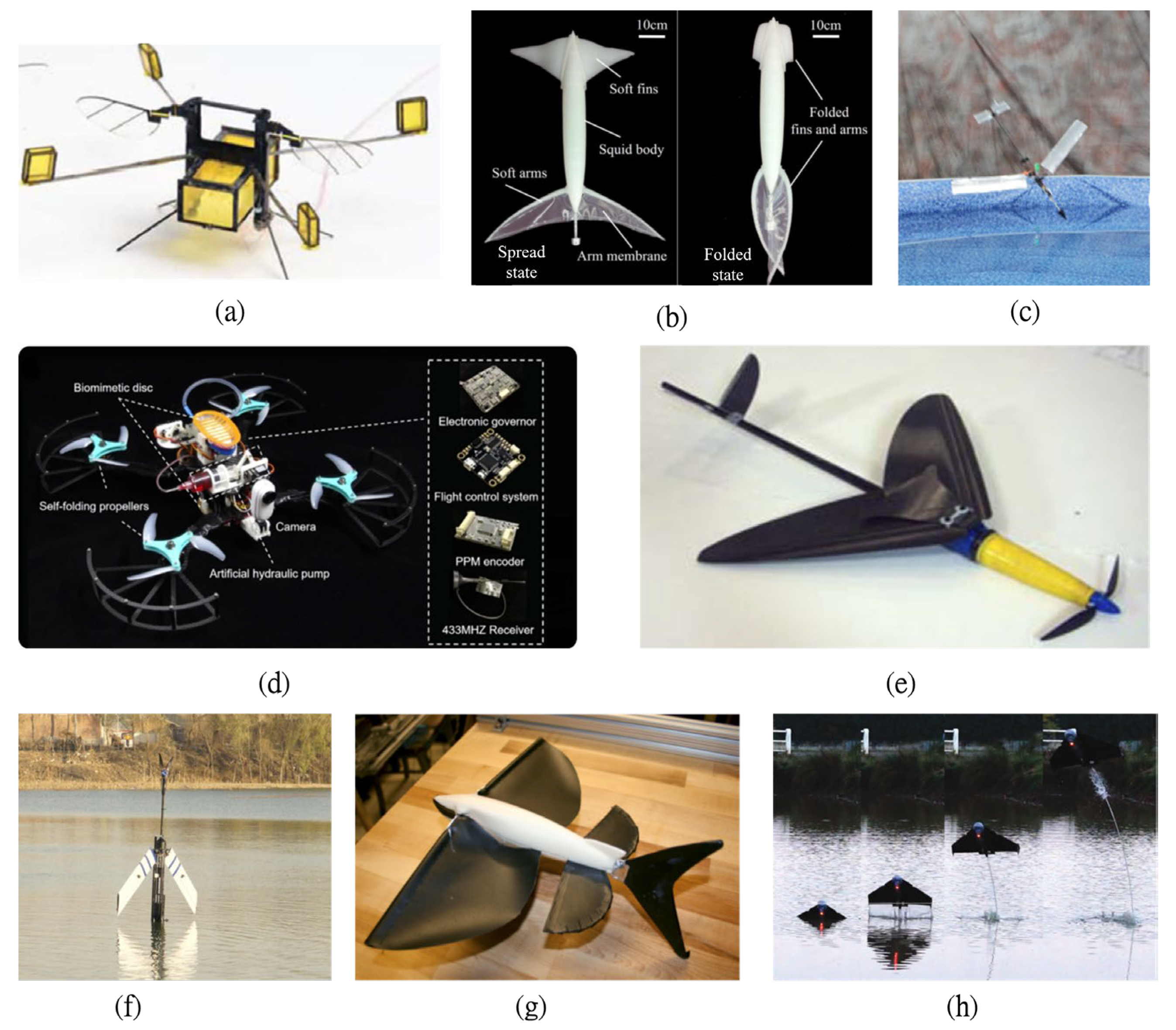
2.2. The VTOL Way HAUVs
2.3. Comparative Analysis of HAUV Types
| Country/Region | Representative Studies | Number of Studies |
|---|---|---|
| China | Nezha series (Nezha-F [57], Nezha-IV [58], Nezha-SeaDart [59], Nezha-H [64], Nezha-X [61]); WuKong [60]; TJ-FlyingFish [52]; Wu et al. flying boat [32]; Plunge-diving gannet [29,30,31,42]; Buoyancy system [68]; Control and stability works [26,27,48,53,66,67]; Early Soviet “flying submarine” concept [6]; Morphable quadrotors [50]; | ~20 |
| USA | Loon Copter [54]; MIT hybrid fish [28,41]; aquatic microrobots [33]; Naviator [46,47]; DARPA submersible aircraft [6]; GTQ-Cormorant [55]; Miniature quadrotor [49]; Dynamic modeling and fixed-wing concepts [35,37,39]; Squid-like soft-morphing vehicle [40]; Morphable quadrotors [51]; Fixed-wing aquatic UAV [36] | ~14 |
| UK | AquaMAV and morphing aquatic MAV (Imperial College London, Kovac Lab) [33,43]; Wing model [2]; IROS aquatic-aerial works [44] | 4 |
| Others (Europe collaboration) | Hitchhiking robots (Science Robotics, ETH/Kovac collaboration) [26]; HyDrone project and propeller configuration [44,45] | 2–3 |
| Total | ~40 |
3. Ocean Optical Instruments and Deployment Methods
3.1. Inherent Optical Instruments and Observation Methods
3.2. Apparent Optical Sensors and Observation Methods
4. Feasibility of Hybrid Aerial Underwater Optical Observation System
5. Amphibious Optical Observation Systems: Potential Applications and Future Work
Author Contributions
Funding
Data Availability Statements
Acknowledgments
Conflicts of Interest
References
- Peng, Z.; Wang, J.; Wang, D.; Han, Q.-L. An Overview of Recent Advances in Coordinated Control of Multiple Autonomous Surface Vehicles. IEEE Trans. Ind. Inform. 2021, 17, 732–745. [Google Scholar] [CrossRef]
- Lock, R.; Vaidyanathan, R.; Burgess, S.C. Development of a biologically inspired multi-modal wing model for aerial-aquatic robotic vehicles. In Proceedings of the IEEE/RSJ International Conference on Intelligent Robots & Systems, Taipei, Taiwan, 18–22 October 2010. [Google Scholar]
- Park, H.; Choi, H. Aerodynamic characteristics of flying fish in gliding flight. J. Exp. Biol. 2010, 213, 3269–3279. [Google Scholar] [CrossRef] [PubMed]
- Zeng, Z.; Lyu, C.; Bi, Y.; Jin, Y.; Lu, D.; Lian, L. Review of hybrid aerial underwater vehicle: Cross-domain mobility and transitions control. Ocean. Eng. 2022, 248, 110840. [Google Scholar] [CrossRef]
- Valdivia y Alvarado, P.; Taher, T.; Kurniawati, H.; Weymouth, G.; Khan, R.R.; Leighton, J.; Papadopoulos, G.; Barbastathis, G.; Patrikalakis, N. A Coastal Distributed Autonomous Sensor Network. In Proceedings of the MTS/IEEE OCEANS Conference, Kona, HI, USA, 19–22 September 2011. [Google Scholar]
- Yang, X.; Wang, T.; Liang, J.; Yao, G.; Liu, M. Survey on the novel hybrid aquatic–aerial amphibious aircraft: Aquatic unmanned aerial vehicle (AquaUAV). Prog. Aerosp. Sci. 2015, 74, 131–151. [Google Scholar] [CrossRef]
- Lu, D.; Guo, Y.; Xiong, C.; Zeng, Z.; Lian, L. Takeoff and Landing Control of a Hybrid Aerial Underwater Vehicle on Disturbed Water’s Surface. IEEE J. Ocean. Eng. 2022, 47, 295–311. [Google Scholar] [CrossRef]
- Lyu, C.; Lu, D.; Xiong, C.; Hu, R.; Jin, Y.; Wang, J.; Zeng, Z.; Lian, L. Toward a gliding hybrid aerial underwater vehicle: Design, fabrication, and experiments. J. Field Robot. 2022, 39, 543–556. [Google Scholar] [CrossRef]
- Bowers, D.G.; Kratzer, S.; Morrison, J.R.; Smith, P.S.D.; Tett, P.; Walne, A.W.; Wild-Allen, K. On the calibration and use of in situ ocean colour measurements for monitoring algal blooms. Int. J. Remote Sens. 2001, 22, 359–368. [Google Scholar] [CrossRef]
- Wang, M.H.; Isaacman, A.; Franz, B.A.; McClain, C.R. Ocean-color optical property data derived from the Japanese ocean color and temperature scanner and the French polarization and directionality of the earth’s reflectances: A comparison study. Appl. Opt. 2002, 41, 974–990. [Google Scholar] [CrossRef]
- Stramska, M.; Stramski, D.; Hapter, R.; Kaczmarek, S.; Ston, J. Bio-optical relationships and ocean color algorithms for the north polar region of the Atlantic. J. Geophys. Res-Oceans 2003, 108, 314310. [Google Scholar] [CrossRef]
- Werdell, P.J.; McKinna, L.I.W.; Boss, E.; Ackleson, S.G.; Craig, S.E.; Gregg, W.W.; Lee, Z.; Maritorena, S.; Roesler, C.S.; Rousseaux, C.S.; et al. An overview of approaches and challenges for retrieving marine inherent optical properties from ocean color remote sensing. Prog. Oceanogr. 2018, 160, 186–212. [Google Scholar] [CrossRef]
- Liu, H.Z.; Zhou, Q.M.; Li, Q.Q.; Hu, S.B.; Shi, T.Z.; Wu, G.F. Determining switching threshold for NIR-SWIR combined atmospheric correction algorithm of ocean color remote sensing. Isprs. J. Photogramm. 2019, 153, 59–73. [Google Scholar] [CrossRef]
- Platt, T.; Sathyendranath, S.; Bouman, H.; Brockmann, C.; McKee, D. Special Issue on Remote Sensing of Ocean Color: Theory and Applications. Sensors 2020, 20, 3445. [Google Scholar] [CrossRef]
- Chen, S.L.; Smith, W.O.; Yu, X.L. Revisiting the Ocean Color Algorithms for Particulate Organic Carbon and Chlorophyll-a Concentrations in the Ross Sea. J. Geophys. Res-Oceans 2021, 126, e2021JC017749. [Google Scholar] [CrossRef]
- Ferreira, A.; Brotas, V.; Palma, C.; Borges, C.; Brito, A.C. Assessing Phytoplankton Bloom Phenology in Upwelling-Influenced Regions Using Ocean Color Remote Sensing. Remote Sens. 2021, 13, 675. [Google Scholar] [CrossRef]
- Balch, W.M.; Drapeau, D.T.; Bowler, B.C.; Booth, E.S.; Goes, J.I.; Ashe, A.; Frye, J.M. A multi-year record of hydrographic and bio-optical properties in the Gulf of Maine: I. Spatial and temporal variability. Prog. Oceanogr. 2004, 63, 57–98. [Google Scholar] [CrossRef]
- Barnard, A.H.; Pegau, W.S.; Zaneveld, J.R.V. Global relationships of the inherent optical properties of the oceans. J. Geophys. Res. Ocean. 1998, 103, 24955–24968. [Google Scholar] [CrossRef]
- Jones, B.H.; Lee, C.M.; Toro-Farmer, G.; Boss, E.S.; Gregg, M.C.; Villanoy, C.L. Tidally driven exchange in an archipelago strait: Biological and optical responses. Oceanography 2011, 24, 142–155. [Google Scholar] [CrossRef]
- Chang, G.C.; Dickey, T.D. Optical and physical variability on timescales from minutes to the seasonal cycle on the New England shelf: July 1996 to June 1997. J. Geophys. Res. 2001, 106, 19997. [Google Scholar] [CrossRef]
- Dall’Olmo, G.; Westberry, T.K.; Behrenfeld, M.J.; Boss, E.; Slade, W.H. Significant contribution of large particles to optical backscattering in the open ocean. Biogeosciences 2009, 6, 947–967. [Google Scholar] [CrossRef]
- Downing, B.D.; Boss, E.; Bergamaschi, B.A.; Fleck, J.A.; Lionberger, M.A.; Ganju, N.K.; Schoellhamer, D.H.; Fujii, R. Quantifying fluxes and characterizing compositional changes of dissolved organic matter in aquatic systems in situ using combined acoustic and optical measurements. Limnol. Oceanogr. Methods 2009, 7, 119–131. [Google Scholar] [CrossRef]
- Wijesekera, H.W.; Pegau, W.S.; Boyd, T.J. Effect of surface waves on the irradiance distribution in the upper ocean. Opt. Express 2005, 13, 9257–9264. [Google Scholar] [CrossRef]
- Slade, W.H.; Boss, E.; Dall’Olmo, G.; Langner, M.R.; Loftin, J.; Behrenfeld, M.J.; Roesler, C.; Westberry, T.K. Underway and Moored Methods for Improving Accuracy in Measurement of Spectral Particulate Absorption and Attenuation. J. Atmospheric Ocean. Technol. 2010, 27, 1733–1746. [Google Scholar] [CrossRef]
- Zaneveld, J.R.V.; Boss, E.; Moore, C.M. A Diver-Operated Optical and Physical Profiling System. J. Atmospheric Ocean. Technol. 2010, 18, 1421–1427. [Google Scholar] [CrossRef]
- Li, L.; Wang, S.; Zhang, Y.; Song, S.; Wang, C.; Tan, S.; Zhao, W.; Wang, G.; Sun, W.; Yang, F.; et al. Aerial-aquatic robots capable of crossing the air-water boundary and hitchhiking on surfaces. Sci. Robot. 2022, 7, eabm6695. [Google Scholar] [CrossRef] [PubMed]
- Wei, T.; Lu, D.; Zeng, Z.; Lian, L. Trans-Media Kinematic Stability Analysis for Hybrid Unmanned Aerial Underwater Vehicle. J. Mar. Sci. Eng. 2022, 10, 275. [Google Scholar] [CrossRef]
- Gao, A.; Techet, A.H. Design considerations for a robotic flying fish. In Proceedings of the Oceans’11 MTS/IEEE KONA, Waikoloa, HI, USA, 19–22 September 2011. [Google Scholar]
- Liang, J.; Yang, X.; Wang, T.; Yao, G.; Zhao, W. Design and Experiment of a Bionic Gannet for Plunge-Diving. J. Bionic Eng. 2013, 10, 282–291. [Google Scholar] [CrossRef]
- Yang, X.; Liang, J.; Wang, T.; Yao, G.; Han, C. Computational simulation of a submersible unmanned aerial vehicle impacting with water. In Proceedings of the IEEE International Conference on Robotics & Biomimetics, Shenzhen, China, 12–14 December 2013. [Google Scholar]
- Liang, J.; Yao, G.; Wang, T.; Yang, X.; Zhao, W.; Song, G.; Zhang, Y. Wing load investigation of the plunge-diving locomotion of a gannet Morus inspired submersible aircraft. Sci. China Technol. Sci. 2014, 57, 390–402. [Google Scholar] [CrossRef]
- Yao, G.; Liang, J.; Wang, T.; Yang, X.; Liu, M.; Zhang, Y. Submersible unmanned flying boat: Design and experiment. In Proceedings of the 2014 IEEE International Conference on Robotics and Biomimetics (ROBIO 2014), Bali, Indonesia, 5–10 December 2014; pp. 1308–1313. [Google Scholar]
- Chen, Y.; Wang, H.; Helbling, E.F.; Jafferis, N.T.; Zufferey, R.; Ong, A.; Ma, K.; Gravish, N.; Chirarattananon, P.; Kovac, M.; et al. A biologically inspired, flapping-wing, hybrid aerial-aquatic microrobot. Sci. Robot. 2017, 2, eaao5619. [Google Scholar] [CrossRef]
- Siddall, R.; Ortega, A.; Kovač, M. Wind and water tunnel testing of a morphing aquatic micro air vehicle. Interface Focus 2017, 7, 20160085. [Google Scholar] [CrossRef]
- Edwards, D.; Arnold, N.; Heinzen, S.; Strem, C.; Young, T. Flying emplacement of an underwater glider. In Proceedings of the OCEANS 2017—Anchorage, Anchorage, AK, USA, 18–21 September 2017; pp. 1–6. [Google Scholar]
- Moore, J.; Fein, A.; Setzler, W. Design and Analysis of a Fixed-Wing Unmanned Aerial-Aquatic Vehicle. In Proceedings of the IEEE International Conference on Robotics and Automation (ICRA), Brisbane, QLD, Australia, 21–25 May 2018; pp. 1236–1243. [Google Scholar]
- Weisler, W.; Stewart, W.; Anderson, M.B.; Peters, K.J.; Gopalarathnam, A.; Bryant, M. Testing and Characterization of a Fixed Wing Cross-Domain Unmanned Vehicle Operating in Aerial and Underwater Environments. IEEE J. Ocean. Eng. 2018, 43, 969–982. [Google Scholar] [CrossRef]
- Guo, D. Modelling and Experimental Investigations of a bi-Modal Unmanned Underwater/Air System. Ph.D. Thesis, RMIT University, Melbourne VIC, Australia, 2019. [Google Scholar]
- Stewart, W.; Weisler, W.; Anderson, M.; Bryant, M.; Peters, K. Dynamic Modeling of Passively Draining Structures for Aerial–Aquatic Unmanned Vehicles. IEEE J. Ocean. Eng. 2020, 45, 840–850. [Google Scholar] [CrossRef]
- Hou, T.; Yang, X.; Su, H.; Jiang, B.; Chen, L.; Wang, T.; Liang, J. Design and Experiments of a Squid-like Aquatic-aerial Vehicle with Soft Morphing Fins and Arms. In Proceedings of the IEEE International Conference on Robotics and Automation (ICRA), Montreal, QC, Canada, 20–24 May 2019; pp. 4681–4687. [Google Scholar]
- Fabian, A.; Feng, Y.; Swartz, E.; Thurmer, D.; Wang, R. Hybrid Aerial Underwater Vehicle; MIT Lincoln Lab: Lexington, MA, USA, 2012. [Google Scholar]
- Wang, T.M.; Yang, X.B.; Liang, J.H.; Yao, G.C.; Zhao, W.D. CFD based investigation on the impact acceleration when a gannet impacts with water during plunge diving. Bioinspir. Biomim. 2013, 8, 036006. [Google Scholar] [CrossRef] [PubMed]
- Zufferey, R.; Ancel, A.O.; Farinha, A.; Siddall, R.; Armanini, S.F.; Nasr, M.; Brahmal, R.V.; Kennedy, G.; Kovac, M. Consecutive aquatic jump-gliding with water-reactive fuel. Sci. Robot. 2019, 4, eaax7330. [Google Scholar] [CrossRef] [PubMed]
- da Rosa, R.T.S.; Evald, P.J.D.O.; Drews-Jr, P.L.J.; Neto, A.A.; Horn, A.C.; Azzolin, R.Z.; Botelho, S.S.C. A Comparative Study on Sigma-Point Kalman Filters for Trajectory Estimation of Hybrid Aerial-Aquatic Vehicles. In Proceedings of the 25th IEEE/RSJ International Conference on Intelligent Robots and Systems (IROS), Madrid, Spain, 1–5 October 2018; pp. 7460–7465. [Google Scholar]
- Horn, A.C.; Pinheiro, P.M.; Silva, C.B.; Alves Neto, A.; Drews, P.L.J., Jr. A Study on Configuration of Propellers for Multirotor-like Hybrid Aerial-Aquatic Vehicles. In Proceedings of the 19th International Conference on Advanced Robotics (ICAR), Belo Horizonte, Brazil, 2–6 December 2019; pp. 173–178. [Google Scholar]
- Maia, M.M.; Soni, P.; Diez, F.J. Demonstration of an Aerial and Submersible Vehicle Capable of Flight and Underwater Navigation with Seamless Air-Water Transition. arXiv 2015, arXiv:1507.01932. [Google Scholar] [CrossRef]
- Maia, M.M.; Mercado, D.A.; Diez, F.J. Design and Implementation of Multirotor Aerial-Underwater Vehicles with Experimental Results. In Proceedings of the IEEE/RSJ International Conference on Intelligent Robots and Systems (IROS), Vancouver, BC, Canada, 24–28 September 2017; 2017; pp. 961–966. [Google Scholar]
- Chen, G.; Liu, A.; Hu, J.; Feng, J.; Ma, Z. Attitude and Altitude Control of Unmanned Aerial-Underwater Vehicle Based on Incremental Nonlinear Dynamic Inversion. IEEE Access 2020, 8, 156129–156138. [Google Scholar] [CrossRef]
- Zha, J.; Thacher, E.; Kroeger, J.; Makiharju, S.A.; Mueller, M.W. Towards breaching a still water surface with a miniature unmanned aerial underwater vehicle. In Proceedings of the International Conference on Unmanned Aircraft Systems (ICUAS), Atlanta, GA, USA, 11–14 June 2019; pp. 1178–1185. [Google Scholar]
- Tan, Y.H.; Chen, B.M. Design of a Morphable Multirotor Aerial-Aquatic Vehicle. In Proceedings of the MTS/IEEE Oceans Seattle Conference (Oceans Seattle), Seattle, WA, USA, 27–31 October 2019. [Google Scholar]
- Tan, Y.H.; Chen, B.M. A Morphable Aerial-Aquatic Quadrotor with Coupled Symmetric Thrust Vectoring. In Proceedings of the IEEE International Conference on Robotics and Automation (ICRA), Electr Network, 31 May–15 June 2020; pp. 2223–2229. [Google Scholar]
- Liu, X.; Dou, M.; Huang, D.; Gao, S.; Yan, R.; Wang, B.; Cui, J.; Ren, Q.; Dou, L.; Gao, Z.; et al. TJ-FlyingFish: Design and Implementation of an Aerial-Aquatic Quadrotor with Tiltable Propulsion Units. In Proceedings of the 2023 IEEE International Conference on Robotics and Automation (ICRA), London, UK, 29 May–2 June 2023; pp. 7324–7330. [Google Scholar]
- Chen, Q.; Zhu, D.; Liu, Z. Attitude control of aerial and underwater vehicles using single-input FUZZY P+ID controller. Appl. Ocean. Res. 2021, 107, 102460. [Google Scholar] [CrossRef]
- Alzu’bi, H.; Mansour, I.; Rawashdeh, O. Loon Copter: Implementation of a hybrid unmanned aquatic–aerial quadcopter with active buoyancy control. J. Field Robot. 2018, 35, 764–778. [Google Scholar] [CrossRef]
- Bershadsky, D.; Haviland, S.; Valdez, P.E.; Johnson, E. Design Considerations of Submersible Unmanned Flying Vehicle for Communications and Underwater Sampling. In Proceedings of the MTS/IEEE Oceans Conference, Monterey, CA, USA, 19–23 September 2016. [Google Scholar]
- Staff. Submersible Drone Can Hide Underwater Then Launch to Perform Aerial Missions. 2016. Available online: https://www.design-engineering.com/new-uav-can-launch-underwater-aerial-missions-1004023004/ (accessed on 15 September 2025).
- Bai, Y.; Jin, Y.; Liu, C.; Zeng, Z.; Lian, L. Nezha-F: Design and Analysis of a Foldable and Self-Deployable HAUV. IEEE Robot. Autom. Lett. 2023, 8, 2309–2316. [Google Scholar] [CrossRef]
- Jin, Y.F.; Bi, Y.B.; Lyu, C.X.; Bai, Y.L.; Zeng, Z.; Lian, L. Nezha-IV: A hybrid aerial underwater vehicle in real ocean environments. J. Field Robot. 2024, 41, 420–442. [Google Scholar] [CrossRef]
- Jin, Y.F.; Zeng, Z.; Lian, L. Nezha-SeaDart: A tail-sitting fixed-wing vertical takeoff and landing hybrid aerial underwater vehicle. J. Field Robot. 2025, 42, 137–152. [Google Scholar] [CrossRef]
- Liu, Y.; Li, C.; Li, J.; Lin, Z.; Meng, W.; Zhang, F. WuKong: Design, Modeling and Control of a Compact Flexible Hybrid Aerial-Aquatic Vehicle. IEEE Robot. Autom. Lett. 2025, 10, 1417–1424. [Google Scholar] [CrossRef]
- Wang, D.; Zhang, Z.; Zeng, Z.; Lian, L. Nezha-X: A Self-Foldable HAUV That can Launch From a Tube. IEEE Robot. Autom. Lett. 2025, 10, 6904–6911. [Google Scholar] [CrossRef]
- Alzu’Bi, H.; Akinsanya, O.; Kaja, N.; Mansour, I.; Rawashdeh, O. Evaluation of an aerial quadcopter power-plant for underwater operation. In Proceedings of the 2015 10th International Symposium on Mechatronics and Its Applications (ISMA), Sharjah, United Arab Emirates, 8–10 December 2015. [Google Scholar]
- Bi, Y.; Xu, Z.; Shen, Y.; Zeng, Z.; Lian, L. Design and Implementation of a Bone-Shaped Hybrid Aerial Underwater Vehicle. IEEE Robot. Autom. Lett. 2024, 9, 7318–7325. [Google Scholar] [CrossRef]
- Song, X.; Bai, Y.; Bi, Y.; Wang, Y.; Zeng, Z.; Zhang, H.; Zhou, F.; Lian, L. Nezha-H: An HAUV for Aerial and Underwater Observation and Sampling. IEEE Robot. Autom. Lett. 2025, 10, 6776–6783. [Google Scholar] [CrossRef]
- Lu, D.; Xiong, C.; Lyu, B.; Zeng, Z.; Lian, L. Multi-Mode Hybrid Aerial Underwater Vehicle with Extended Endurance. In Proceedings of the 2018 OCEANS—MTS/IEEE Kobe Techno-Oceans (OTO), Kobe, Japan, 28–31 May 2018; pp. 1–7. [Google Scholar]
- Lu, D.; Xiong, C.; Zeng, Z.; Lian, L. Adaptive Dynamic Surface Control for a Hybrid Aerial Underwater Vehicle With Parametric Dynamics and Uncertainties. IEEE J. Ocean. Eng. 2020, 45, 740–758. [Google Scholar] [CrossRef]
- Lu, D.; Xiong, C.; Zhou, H.; Lyu, C.; Hu, R.; Yu, C.; Zeng, Z.; Lian, L. Design, fabrication, and characterization of a multimodal hybrid aerial underwater vehicle. Ocean. Eng. 2021, 219, 108324. [Google Scholar] [CrossRef]
- Hu, R.; Lu, D.; Xiong, C.; Lyu, C.; Zhou, H.; Jin, Y.; Wei, T.; Yu, C.; Zeng, Z.; Lian, L. Modeling, characterization and control of a piston-driven buoyancy system for a hybrid aerial underwater vehicle. Appl. Ocean. Res. 2022, 120, 102925. [Google Scholar] [CrossRef]
- Boss, E.; Guidi, L.; Richardson, M.J.; Stemmann, L.; Gardner, W.; Bishop, J.K.B.; Anderson, R.F.; Sherrell, R.M. Optical techniques for remote and in-situ characterization of particles pertinent to GEOTRACES. Prog. Oceanogr. 2015, 133, 43–54. [Google Scholar] [CrossRef]
- Li, L.; Stramski, D.; Darecki, M. Characterization of the Light Field and Apparent Optical Properties in the Ocean Euphotic Layer Based on Hyperspectral Measurements of Irradiance Quartet. Appl. Sci. 2018, 8, 2677. [Google Scholar] [CrossRef]
- Lee, Z.P.; Arnone, R.; Hu, C.M.; Werdell, P.J.; Lubac, B. Uncertainties of optical parameters and their propagations in an analytical ocean color inversion algorithm. Appl. Opt. 2010, 49, 369–381. [Google Scholar] [CrossRef]
- McClain, C.R.; Feldman, G.C.; Hooker, S.B. An overview of the SeaWiFS project and strategies for producing a climate research quality global ocean bio-optical time series. Deep. Sea Res. Part II Top. Stud. Oceanogr. 2004, 51, 5–42. [Google Scholar] [CrossRef]
- Waters, K.J.; Smith, R.C.; Lewis, M. Avoiding Ship-Induced Light-Field Perturbation in the Determination of Oceanic Optical Properties. Oceanography 1990, 3, 8–21. [Google Scholar] [CrossRef]
- Hooker, S.B.; Maritorena, S. An Evaluation of Oceanographic Radiometers and Deployment Methodologies. J. Atmos. Ocean. Technol. 2000, 17, 811–830. [Google Scholar] [CrossRef]
- Voss, K.J.; Nolten, J.W.; Edwards, G.D. Ship Shadow Effects On Apparent Optical Properties. In Proceedings of the 1986 Technical Symposium Southeast, Orlando, FL, USA, 1–4 April 1986. [Google Scholar]
- Doyle, J.P.; Zibordi, G. Optical Propagation within a Three-Dimensional Shadowed Atmosphere–Ocean Field: Application to Large Deployment Structures. Appl. Opt. 2002, 41, 4283–4306. [Google Scholar] [CrossRef]
- Gordon, H.R.; Ding, K. Self-shading of in-water optical instruments. Oceanography 1992, 37, 491–500. [Google Scholar]



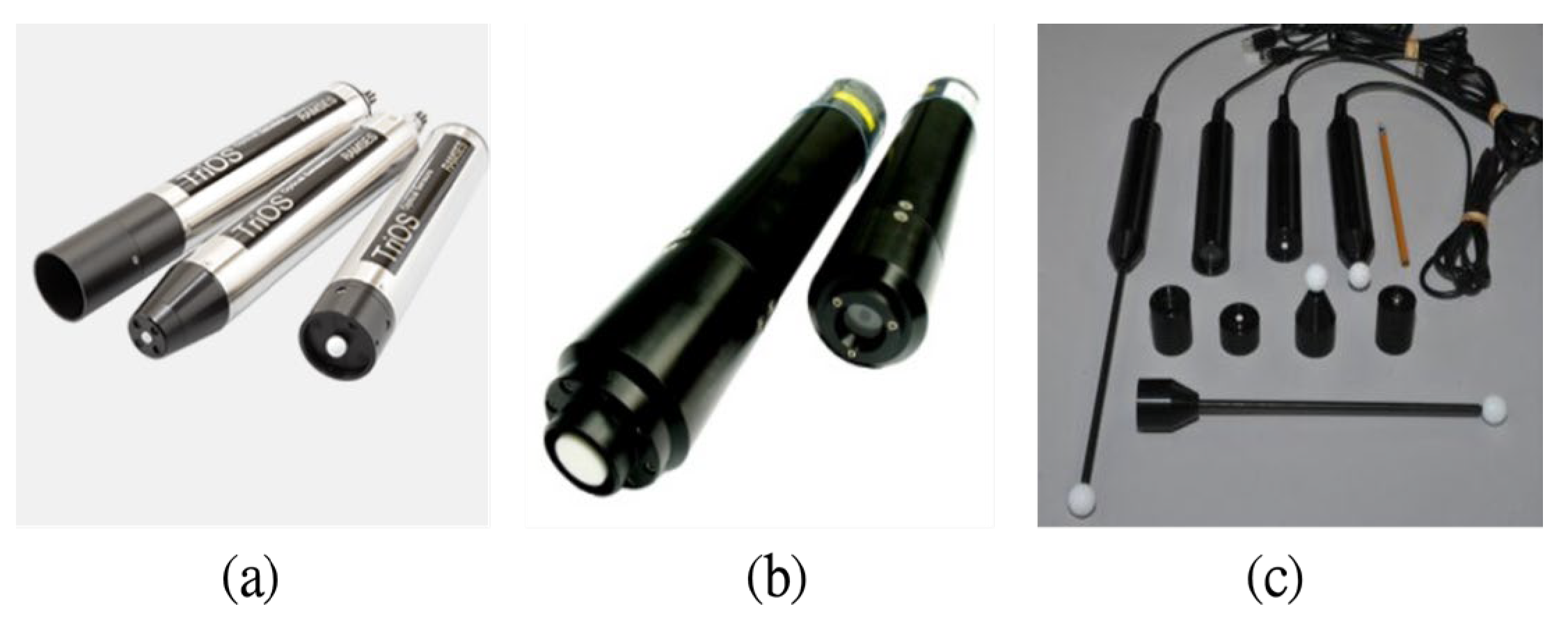


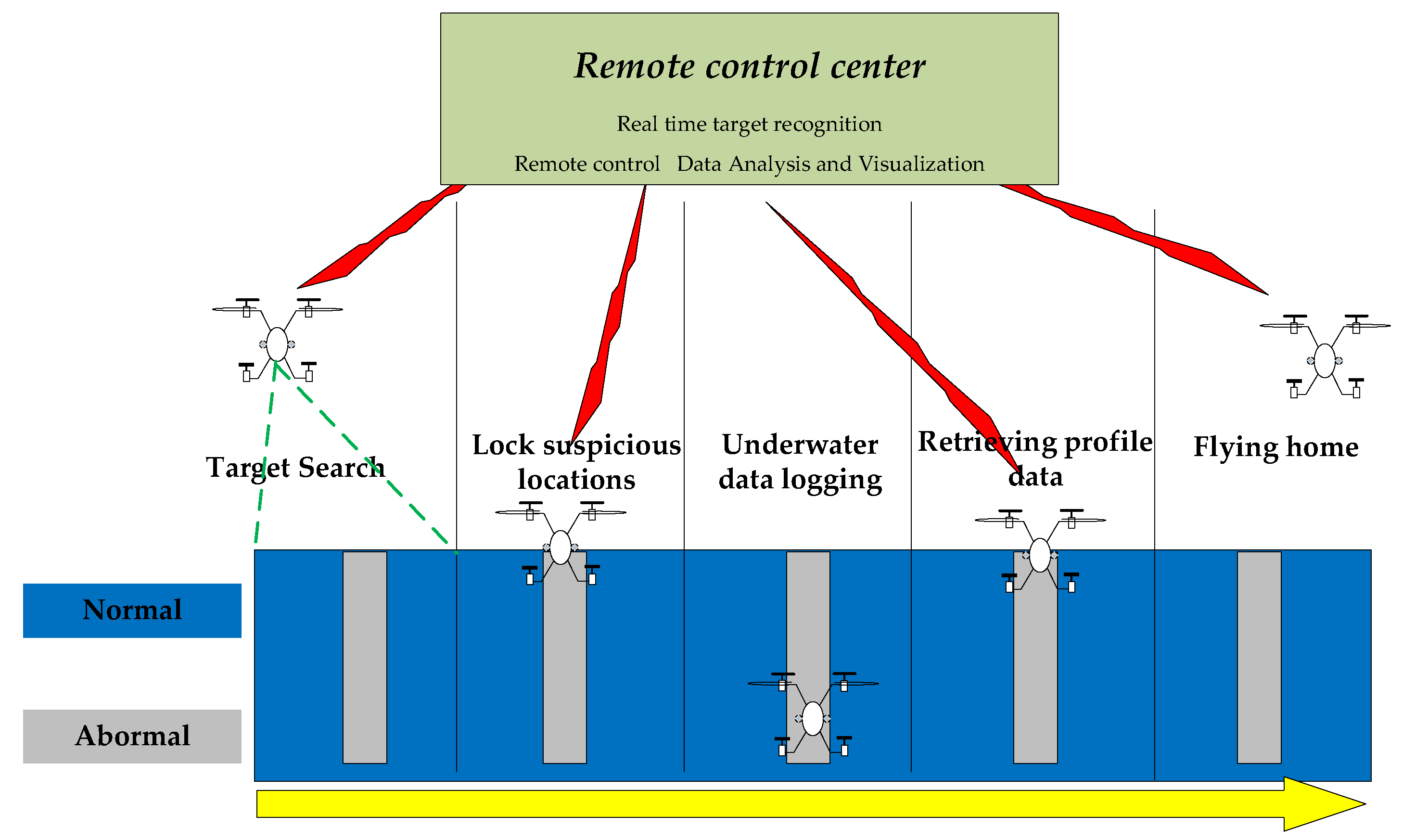
| Type of HAUV | Transition Mechanism | Payload Capacity | Underwater Maneuverability | Aerial Endurance | Stability in Water Entry | Representative Applications |
|---|---|---|---|---|---|---|
| Bio-inspired | Plunge-dive biomimetic | Low (miniaturized) | Moderate (limited control) | Moderate | Sensitive to turbulence | Small-scale monitoring proof-of-concept research |
| Fixed-wing (splash) | Glide or tilt entry | Medium | Low (propellers are inefficient) | High (long range) | High risk of vibration | Wide-area patrols rapid deployment |
| VTOL Multi-rotor | Vertical descent/ascent | Medium–High | High (hover precise positioning) | Short–Moderate | Smooth controllable | Optical profiling localized surveys |
| Multi-modal HAUV | VTOL + gliding capability | Medium | High (gliding + hovering) | Moderate–High | Stable with buoyancy system | Long-duration surveillance adaptive missions |
| Instrument | 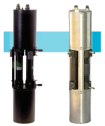 | 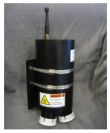 |  | 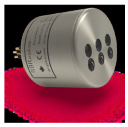 |
| Spectral absorption and attenuation sensor (ac-s) | ECO BB9 | ECO fluorometers and scattering sensors | RBR tridente | |
| Company | WET Labs, Inc., Philomath, OR, USA | WET Labs, Inc., Philomath, OR, USA | WET Labs, Inc., Philomath, OR, USA | RBR Ltd., Ottawa, ON, Canada |
| weight in air /water | 5.9 kg/0.8 kg | 3.1 kg/1.8 kg | 0.4 kg/0.21 kg | 0.4 kg/0.02 kg |
| observation parameters | c(λ), b(λ), a(λ), bp(λ) | Fluorescence, bp(λ) | Fluorescence, bp(λ) | Fluorescence, bp(λ) |
| deployment platforms | CTD rosettes, Float profiler, AUV, ROV, Buoy | |||
| Compatibility with HAUVs | Limited—heavy and high power, suitable only for large HAUVs | Moderate—feasible for mid-size HAUVs with endurance capacity | High—light weight, low power, suitable for small HAUVs | High—excellent compatibility with miniaturized HAUVs |
Disclaimer/Publisher’s Note: The statements, opinions and data contained in all publications are solely those of the individual author(s) and contributor(s) and not of MDPI and/or the editor(s). MDPI and/or the editor(s) disclaim responsibility for any injury to people or property resulting from any ideas, methods, instructions or products referred to in the content. |
© 2025 by the authors. Licensee MDPI, Basel, Switzerland. This article is an open access article distributed under the terms and conditions of the Creative Commons Attribution (CC BY) license (https://creativecommons.org/licenses/by/4.0/).
Share and Cite
Qi, H.; Hu, S.; Zhang, J.; Wu, G. Review of Hybrid Aerial Underwater Vehicle: Potential Applications in the Field of Underwater Marine Optics. Drones 2025, 9, 667. https://doi.org/10.3390/drones9100667
Qi H, Hu S, Zhang J, Wu G. Review of Hybrid Aerial Underwater Vehicle: Potential Applications in the Field of Underwater Marine Optics. Drones. 2025; 9(10):667. https://doi.org/10.3390/drones9100667
Chicago/Turabian StyleQi, Hongyu, Shuibo Hu, Jiasheng Zhang, and Guofeng Wu. 2025. "Review of Hybrid Aerial Underwater Vehicle: Potential Applications in the Field of Underwater Marine Optics" Drones 9, no. 10: 667. https://doi.org/10.3390/drones9100667
APA StyleQi, H., Hu, S., Zhang, J., & Wu, G. (2025). Review of Hybrid Aerial Underwater Vehicle: Potential Applications in the Field of Underwater Marine Optics. Drones, 9(10), 667. https://doi.org/10.3390/drones9100667







